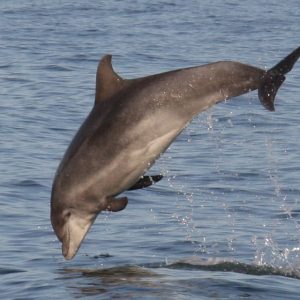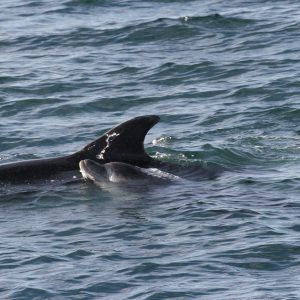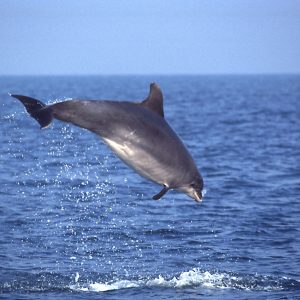Dolphin and whale facts
What are whales and dolphins?
What are Cetaceans?
Living in Water
Dolphin Facts
Whale Facts
Climate Change
What Can I Do?
What are the Threats?
What are whales and dolphins?
- Whales and dolphins (and porpoises) are mammals that live in an aquatic environment (in water), mostly the sea although a few species live up rivers. They are known as ‘cetaceans’.
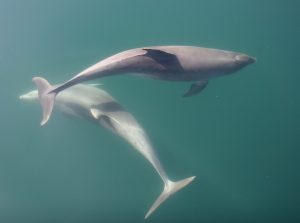
Bottlenose dolphins. P.Anderwald
What are mammals?
- Humans are mammals, and together with other animals, like whales, dolphins, and land-based animals like elephants, bears, lions etc, we all form a group of animals known as mammals. Mammals have hair, lungs, are warm blooded, can live on land or in water, and give birth to live young (apart from the duck-billed platypus and the echidna who lay eggs).
How are whales & dolphins similar to other mammals, and how do they differ?
-
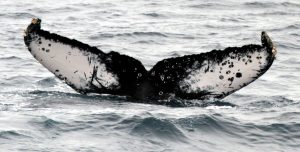
Humpback whale tail flukes. P.G.H.Evans
Whales are warm blooded animals (they keep a high body temperature that doesn’t change in the cold water), they breathe air, have
some hair (albeit sparse) and give birth to live young, feeding them with milk frommammary glands. Unlike most other mammals, however, whales do not have external hind limbs, their forelimbs are modified into flippers, they have extra vertebrae in their trunk and back, and flukes on their tails for locomotion, and their nostrils are situated at or near the top of the head rather than the tip of the snout.
What’s in a name?
- Whale comes from the Anglo Saxon hwael meaning ‘a large fish’
- Dolphin comes from the Greek delphin and in fact the common dolphin’s latin name is Delphinus delphis.
- Porpoise derives from the Latin phrase porcus, which means hog and piscis meaning fish, literally meaning sea pig. The porpoise’s relationship to a pig is found in many names, for example, in South America it is known as chancho mariono which means sea pig and in Germany it is called meerschwein also meaning sea pig.
What are Cetaceans?
- Whales, dolphins and porpoises are known as cetaceans. There are 14 baleen whale species, 3 sperm whales, 22 beaked whales, 2 monodontids (narwhal and beluga), 38 oceanic dolphins, 4 river dolphins and 7 porpoises. The number of species recorded in the world has increased as modern genetic techniques reveal differences that previously we could not easily detect.
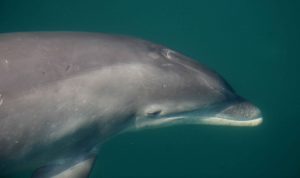
Bottlenose dolphin. Sea Watch Foundation
How many species of whales, dolphins and porpoises exist today?
- There are 90 species of whales, dolphins and porpoises (cetaceans). The number of species recorded in the world has increased in recent years as modern genetic techniques reveal differences that previously we could not readily detect.
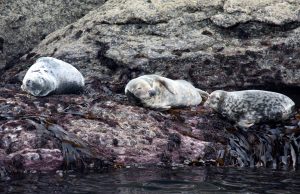
Grey seals. Sea Watch Foundation
Are seals in the same category as cetaceans?
- No, marine mammals are classified into four different taxonomic groups: cetaceans (whales, dolphins, and porpoises), pinnipeds (seals, sea lions, and walruses), sirenians (manatees and dugongs), and marine fissipeds (polar bears and sea otters).
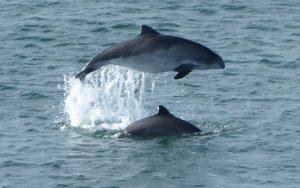
A porpoise pair. Sea Watch Foundation
What is the difference between a dolphin and a porpoise?
- Dolphins tend to have more prominent, long shaped “beaks” and they have cone-shaped teeth with a hooked/ curved dorsal fin. Porpoises have smaller jaws and spade-shaped teeth with a triangular dorsal fin.
How variable in size are different species (which is the largest and which is the smallest)?
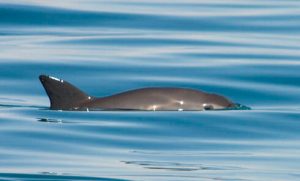
Highly endangered Vaquita. A.Jefferson
-
The world’s smallest cetacean is the vaquita porpoise Phocoena sinus, which means ‘little cow’. These small whales grow to around 1.5 metres (4.5 feet) long and weigh c. 55 kg (120 pounds).The vaquita now only exists in a small area in the northernmost part of the Upper Gulf of California in Mexico. They are the smallest marine cetacean in the world and sadly the most endangered. Other small species include the harbour porpoise Phocoena phocoena (adult length 1.4-1.9 m length), and Burmeister’s porpoise Phocoena spinipinnis (1.5-1.9 m length). The smallest species called a whale is the dwarf pygmy sperm whale Kogia simus (2.5-2.7 m length).The largest cetacean is the blue whale (Balaenoptera musculus). It is also the largest
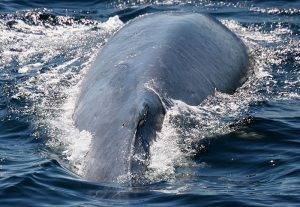
The mighty blue whale. P.G.H.Evans
animal on Earth! Adult length in the northern hemisphere can be: female: 25 m; male: 24 m. Adult weight: 50,000 – 150,000 kg. Blue whales in the southern hemisphere are generally larger, with the
largest specimen ever measured having been over 33 m long.The killer whale or orca (Orcinusorca) grows up to 31 feet (9.4 metres) making it the largest dolphin on earth. So, there are many different shapes and sizes in between.
Living in Water
Why do some whales and dolphins have a dorsal fin?
-
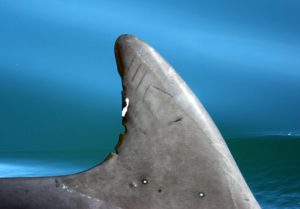
Dorsal fin of bottlenose dolphin. Sea Watch Foundation
The dorsal or back fin stabilises the mammal in the same way as a keel on a sailboat stabilises a boat. Most whales and dolphins have a dorsal fin, but in some it has been reduced to just a series of bumps, such as in the sperm whale. In some it has been lost
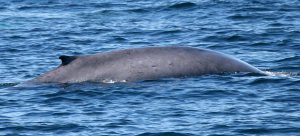
A blue whale has a tiny dorsal fin. P.G.H.Evans
altogether such as in the beluga, narwhal and right whales.
How well do whales and dolphins see?
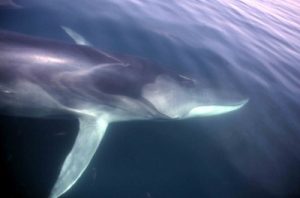
Fin Whale. P.G.H.Evans
- Whales and dolphins have excellent vision, both in the water and in the air. The only species of dolphins with reduced vision are the river dolphins found in the Amazon, Ganges and Indus rivers. Here the eye is simply a slit 2-3 mm in diameter.
What is Sounding?
- Sounding is a word used when whales and dolphins dive down deeply into the water, usually to look for food.
What is Breaching?
-
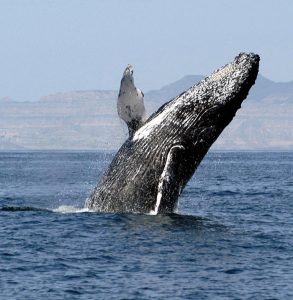
Humpback breaching. M.Somerville
Breaching is when whales and dolphins launch their bodies out of the water almost vertically. They then descend onto their backs with a huge crash. Humpbacks will breach during courtship, in the winter months.
How deep can whales and dolphins dive?
- Most whales and dolphins spend most of their time swimming in 100 metres of water because this is where food is most plentiful. Scientific studies have shown, however, that sperm whales can dive as deeply as 1,185 metres, whilst a bottlenose whale dived to an incredible depth of 1,453 metres off the coast of Nova Scotia. Bottlenose whales can hold their breath for up to 2 hours!
- A captive bottlenose dolphin was trained by the US Navy to dive as deeply as 535 meters.
What is a Blow?
-
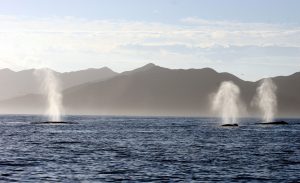
Blows from three grey whales. P.G.H.Evans
A blow is an outward breath of a whale or dolphin and is explosive! Sometimes the species can be identified by their blows. Often the blows are 5-6 metres high and are visible for several miles. An experienced observer can estimate the size of the individual by the height of the blow. Baleen whales produces a double blow, because they have two nostrils instead of one, although the double blow often merges into one single plume, as in the humpback whale.
- When a blue whale exhales, the spray from its blowhole can reach nearly 30 ft (9m) into the air.
Male or Female?
-
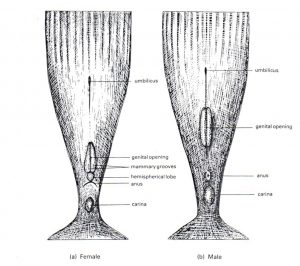
Genders
The underside of a dolphin tells us if it is male or female. Males have their genital slit much higher up compared to the females which is nearer the fluke area, where the anus is.
Do whales and dolphins sleep?
- Whales and dolphins do not sleep in the same way that we do and the reason for this is that when they sleep they stop breathing. So they can only sleep or doze for short periods. Some whales doze just under the surface of the water, rising up just enough to take a breath. Sometimes ships run over whales ‘sleeping’ in the shipping lanes.
However, they can also go into a semi-sleep mode where one half of the brain switches off but they continue to surface for breaths.
How do whales and dolphins make sounds?
- This isn’t an easy question to answer, because whales and dolphins don’t have vocal cords like humans do. In dolphins the low frequency whistle sounds they make are thought to be produced by their larynges, and the high-pitched clicks by the complex structure in their foreheads.
- The sounds that humpback whales make are known as whale songs. Whale songs like bird song serve as a means of communication. Only male humpbacks actually sing and it is one of the best ways to advertise for a mate!
- Recent studies carried out with the bottlenose dolphins in Cardigan Bay in West Wales have shown that they have their own accent and that their whistle is slightly different from other dolphins from western Ireland, for example!
Dolphin Facts
How do dolphins keep warm?
- Dolphins have a layer of blubber under their skin which keeps them warm. They also have less of their body mass exposed to the outside, which means they cool more slowly. They are also able to ‘pump out’ metabolic body heat faster than we can. Their bodies are very clever because they can change the flow of blood, so that it stays within the body, and not flowing into their outer body parts e.g. tail (fluke) and fins.
What is a blackfish?
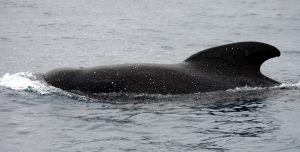
Long-finned pilot whale. P. Anderwald
- Blackfish, is the slang term for small, dark-coloured toothed whales. Some examples of these whales are the false killer whale, pygmy killer whale, and long-finned pilot whale.
Whale Facts
What are the differences between Baleen and Toothed Whales?
- Baleen whales don’t have teeth (mysticetes) and toothed whales (odontocetes) do, and the difference reflects a fundamental difference in feeding habits. Baleen whales, like the blue whale, are the largest in size. There are 14 baleen whales in total and they feed on plankton, krill (little shrimps) and small fish, from the sea water.
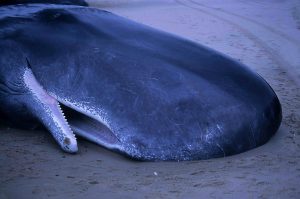
Teeth showing in sperm whale’s mouth. RW Baird
Toothed whales account for all the remaining 76 species of whales, dolphins and porpoises and they all have varying numbers of teeth. They hunt and feed on individual prey, for example, larger fish, squid, octopus and sometimes other small mammals. Another difference is that toothed whales use echolocation, mentioned in your “All about Dolphins” booklet, emitting high frequency bursts of sound that reflect back from their prey. There is no evidence of baleen whales using echolocation.
If Baleen whales don’t have teeth, what do they have instead?
- They have lines of bristles called baleen, formed from the same substance that makes fingernails and hair. These bristles are continuously worn away and then
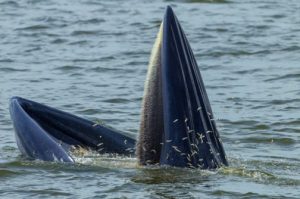
A Bryde’s whale gulping down gallons of water containing thousands of tiny krill. It then uses its baleen to keep the krill whilst getting rid of the water. Sea Watch Foundation
regenerated. The bristles enable the whale to trap the prey it takes into its mouth whilst releasing the sea water at the same time!
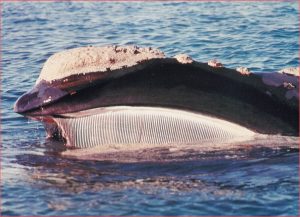
Baleen hanging from upper jaw of right whale. Fugarte
What are rorquals?
- Rorquals are the largest group of baleen whales. This group of whales include the blue whale, the fin whale and the northern minke whale.
What are beaked whales?
-
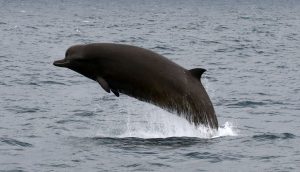
Northern-bottlenose whale. Saana Isojunno
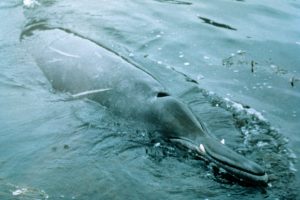
Sowerby’s beaked whale. J.Benney
Beaked whales are not easily seen by humans due to the fact that they are deep-diving animals that forage on deep sea squids, found offshore in waters sometimes as deep at 3,000 metres! They catch their squid or octopus prey by sucking them into their mouths. They have no teeth showing other than one to two pairs in the lower jaw. These teeth usually show only in adult males where they are used to establish dominance and as tools for fighting. Their
dorsal fins are usually small, triangular and far back on the animal’s body. Sadly, these beaked whales can be affected by noise pollution from navy sonar and seismic exploration. They may try to avoid such loud noises by interrupting their dive rising rapidly towards the surface and swimming quickly away without a full recovery dive. Losing the ability to manage gases under pressure, the result of that can be the build-up of nitrogen in tissues causing gas bubbles (termed emboli) to form, leading to disorientation and ultimately stranding.
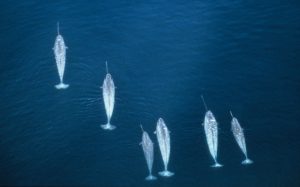
A pod of Narwhal. A.Martin
Do whales have tusks?
- The male narwhal does! A tusk is simply a long pointed tooth, which sticks out from a whale’s mouth even when it is closed. The male narwhal has one upper tusk which can be as long as 3 metres.
Do all whales migrate?
- All whales move around a lot but only some species undergo long migrations, and even within a species or population, not every whale may migrate. For example, the smaller juvenile humpback whales may not travel as far as adults to tropical regions as they are not mature enough to reproduce. These younger whales often stay in cooler waters and exploit the prey that occurs there even in the winter. Mature sperm whales, particularly females, on the other hand may remain year-round in the tropics.
Why do whales migrate?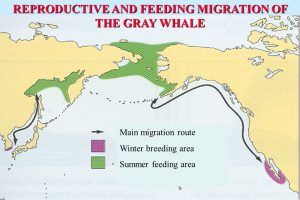
- A number of whales migrate long distances annually because the conditions favouring breeding and feeding are in widely separated regions. Some species of whales undertake migrations amounting to thousands of kilometres, between feeding grounds in polar regions and safe breeding areas in the tropics.
How far can whales travel?
- Whales can travel a few thousand miles during a single migration. In fact, humpback whales can migrate further than any other mammal on Earth. They can travel around 3,000 miles (5,000 kilometres) each way between their breeding and feeding grounds on a regular basis.
Do whales feed on migration?
- The adult whales feed on swarms of plankton in polar regions during the summer, but do not eat (or only a small amount) throughout the winter when they are migrating or breeding due to lack of food available, Whilst they are having calves, they rely on their fat stores, known as blubber. Migrating whales can travel 6,000 miles or 10,000 kilometres (there and back).
How do scientists track whales?
- Scientists use either GPS or satellite technology. By using images taken from space (385 miles above the Earth’s surface), researchers have been able to plot migratory patterns of different species of baleen whales. They hope that this information will give us a better understanding of how these amazing mammals survive through the different seasons and with the challenging environmental changes they face each year.
How are whales adapted to life in water?
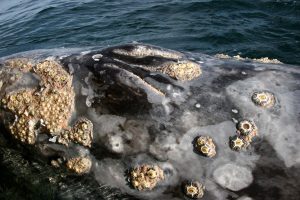
Barnacles on a grey whale. P.G.H.Evans
Body Surface
- The hair that covers most mammals is massively reduced in cetaceans. Hair is a poor insulator when wet and would also increase drag when the whales are swimming. Some hairs are still found on the head of some whales, with isolated follicles on the lower jaw and snout area – thought to be the remnants of vibrissae (sensory whiskers). Skin pigmentation on cetaceans can help one identify individuals in a species. Without the hair coverage, the epidermis may produce markings – most commonly in black and white although small wounds can be affected by various growths and organisms that live on the cetacean’s skin, such as yellow algae and whitish organisms that live on the lower surface of some cetaceans. Some cetaceans also play host to barnacles (see photo of the grey whale).
Adaptations for locomotion
- How cetaceans move around is the most noticeable adaptation to life in the water. Instead of horizontal planes of movement as in crocodiles for example, cetaceans use vertical strokes to swim. They have evolved from four legged terrestrial mammals to almost limbless aquatic mammals where their back muscles are most important. Cetaceans still do have forelimbs; however, they have become reduced to fins/flippers such as shortened arm bones with all individual fingers inside the one fin/flipper. The hind legs are totally gone, leaving only vestigial elements. Pelvic similarities are found in all cetaceans apart from the dwarf and pygmy sperm whales. The flippers allow the cetacean to steer, whilst back muscles drive the tail to propel forwards. Horizontal flukes have developed to increase the propulsion area created by the back muscles.
Respiration
-
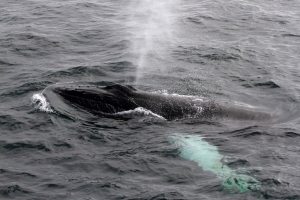
Humpback whale exhaling. P.G.H.Evans
Cetaceans normally breathe whilst moving through the water and spend short periods of time on the surface to exhale in a quick hard ventilation (blow). This blow can be compared to our coughs. However, they use up to 80% of their lung volume in this single breath compared to the small amount that humans do (20%). When terrestrial mammals lose consciousness, they still automatically breathe. However, cetaceans cannot do this. So, if a whale becomes unconscious, it cannot breathe and will quickly die if not helped.
Circulation and thermoregulation
- Cetaceans, have a four-chambered heart with paired ventricles and auricles just like all mammals. However, the only difference is that they have a larger series of well-developed reservoirs for oxygenated blood. These provide bypasses that enable cetaceans to isolate skeletal muscle circulation during diving while using the oxygen stored in the remaining blood to maintain the heart and brain—these organs depend on the supply of oxygen to survive. Whales have a particularly high concentration of oxygen in the blood, stored in their myoglobin. To stop the cetaceans from losing body heat so easily their bodies have evolved certain adaptations: reduced external appendages for less heat loss and better locomotion, a layer of blubber, and also a counter-current blood circulation, with fine capillary blood vessels at the extremities which can shut off blood flow. In whales, a layer of the skin (dermis) has evolved into a blanket of blubber, which is extremely rich in fats and oils, and therefore conducts heat poorly. This blanket covers the entire body, making up a significant portion of the animal’s weight.
Do killer whales deserve their name?
- The name killer whale implies a deadly animal
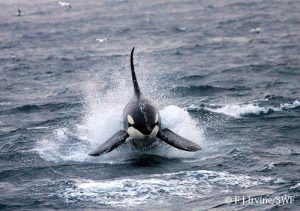
Killer whale (Orca) is a top predator. J.Irvine
whose predatory behaviour is unique amongst the animal kingdom and should send fear tingling down one’s spine. It is true that they are extremely efficient hunters and are able to take down a wide variety of other marine animals – not just fishes but also birds and mammals – sea lions, seals, porpoises and even large whales. However, it is very rare for them to attack humans (cases of this almost always involve captive animals). When capturing such prey, they use a mix of guile, speed and agility along with a lot of stamina and some massive teeth (which can grow up to 4 inches or 10 cm). Although unusual for cetaceans, many other species will feed on other mammals, and so we may prefer to call the killer whale by its alternative name of orca.
Climate Change
What is climate change?
- Climate is the average weather that occurs in a place over many years. For example, here in the UK we have a ‘temperate’ climate which generally means we get cool, dry winters, and warm, wet summers. BUT, the climate is changing all over the world and this is called climate change.
How is the climate changing?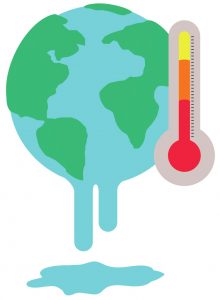
- Temperatures are rising, which means that Planet Earth is becoming warmer both on land and in the sea. This has been happening particularly over the last 50 years.
Why are temperatures increasing?
- The planet is warming up due to a number of reasons – we burn fossil fuels (coal, oil and gas) so that we can run businesses and factories, drive our cars, and heat our homes. Fossil fuels are non-renewable (once they are gone they are gone), and they are bad for the environment because they release carbon dioxide (a greenhouse gas).
What is carbon dioxide?
Carbon dioxide is an important gas that makes up the Earth’s atmosphere along with oxygen and nitrogen. It helps to trap heat in our atmosphere and, without it, life would be very cold! However, the amount of carbon dioxide in the atmosphere is increasing to levels that is making the Earth’s temperature rise too much. Humans are relying on fossil fuels far too much for their daily lives.
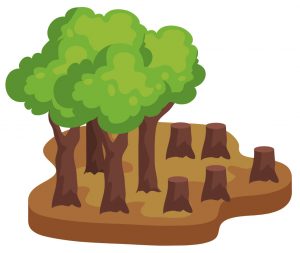
What else is releasing carbon dioxide?
Human activities such as deforestation (cutting down forests), burning fossil fuels, and burning fires all release carbon dioxide into the environment, but natural events such as volcanic eruptions also release it. In addition, the emissions of various manufactured chemicals (such as those used in paints, spray cans, glue, fridge chemicals, foams etc) can deplete the ozone layer in the atmosphere which otherwise protects the earth from overheating.
What can we do to stop carbon levels from going up?
- If we stopped cutting down trees (deforestation) that would really help because trees actually reduce the levels of carbon dioxide in the atmosphere during the process
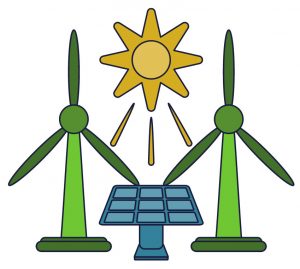 of photosynthesis (when green plants and other organisms capture energy from sunlight to produce oxygen and chemical energy).
of photosynthesis (when green plants and other organisms capture energy from sunlight to produce oxygen and chemical energy). - If we stopped relying on energy from burning fossil fuels and we used renewable energy more often, for example, solar, wind, tidal, geothermal, or biomass energies.
What can I do?
There are many things that you can do to limit your carbon footprint. Some are:
- Eat less meat. Animals (cattle) create greenhouse gas emissions, and looking after them and making sure they are fed properly takes up valuable land, which we could be using to grow more crops, or even more trees!
- Eat locally grown and seasonal fruit and vegetables
- Don’t waste food
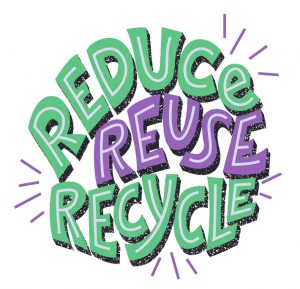
- Re-use plastic bags or even better, bring your own!
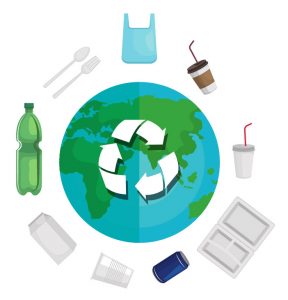 Recycle more – donate clothes you no longer need to second hand shops, and try buying clothes from second hand shops.
Recycle more – donate clothes you no longer need to second hand shops, and try buying clothes from second hand shops.- Use public transport more often, or jump on your bike!
- Try turning down the thermostat in the house by just 1 degree. It’ll make a BIG difference.
- Don’t waste water by leaving the tap running, and try jumping in a quick shower, instead of always having a bath.
- Unplug equipment when not in use.
Do whales really help with carbon levels?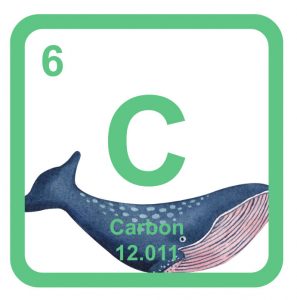
Yes! They absolutely do. Whales build up large amounts of carbon in their bodies over their lifetime. For example, one humpback whale can carry 30,000 tonnes of carbon which will go to the bottom of the ocean when its body sinks after death. When carbon is stored in this way, scientists call it ‘blue carbon’.
What are the threats facing cetaceans?
Whales and dolphins have to face five main threats every day of their lives. These are: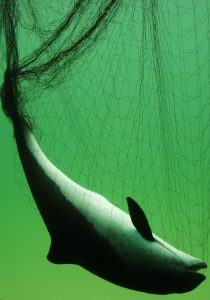
- Bycatch (being accidentally caught in fishing nets)
- Ship strikes (when boats or ships accidentally hit cetaceans)
- Overfishing (when humans take too much fish from the oceans for themselves and don’t think about the other species who also need to eat!)
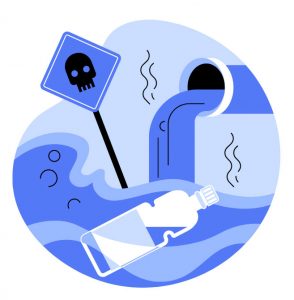 Pollution (when cetaceans are affected by our rubbish and waste)
Pollution (when cetaceans are affected by our rubbish and waste)- Disturbance (this is usually when human activity causes noise that affects cetaceans in different ways)
There are other threats such as hunting and climate change. Hunting only occurs in some countries, certainly not in the UK, and climate change affects all creatures on the planet, not just cetaceans.
Let’s look at the threats in more detail..
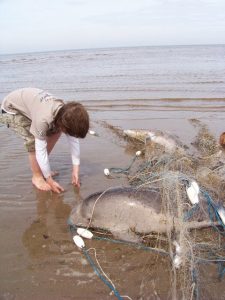
Two porpoise bycaught in ghost netting
Bycatch
Bycatch is when something is caught in a net (or other fishing equipment/gear) that the fishermen didn’t intend to catch. For example, if a fishing boat goes out to catch fish such as mackerel or cod (target prey), and accidentally catch haddock or even worse, a dolphin (bycatch)! This happens because fishing equipment is very efficient (designed well for catching fish), and it doesn’t allow for fish or animals to escape. All sorts of animals can get bycaught, for example, turtles, sharks, sea birds, fish, and marine mammals (whales, dolphins, porpoise & seals).
There are many different types of fishing equipment (fishing gear) available, and each is carefully designed to catch different types of fish. You may have heard of trawlers, gill nets, long lines, purse seines, pole and line and pots and traps. A lobster pot is an easy example, it’s designed to catch lobsters! Trawlers, such as bottom trawlers are designed to catch flat fish (plaice, sole, dab and flounder for example) and other animals that live on the seabed, like shrimp. Gill nets are designed to catch larger fish such as, salmon, tuna and cod.
Gill nets and trawlers are the worst fishing gear for catching dolphins. Gill nets are set up far out at sea, and hang like enormous curtains in the water. The problem is that the net itself is virtually invisible to animals because it’s made from very thin, transparent (see through) material that a dolphin only picks up with its sonar (echolocation) sometimes too late! When dolphins swim they are constantly echolocating (looking) ahead and around themselves (just like we do when we walk down the street), and if they comes across lots of tasty look fish in the water, it can be too tempting to miss! They get caught up (entangled) in the fine mesh and drown because they can’t get to the surface to breathe.
Trawlers work in a different way. They are huge, cone-shaped nets with a closed end, that are dragged behind one or two boats along the seabed and are designed to scoop up anything in their path. They can be very damaging to the seabed because nothing really survives behind them, and curious, hungry dolphins who see the tasty fish inside the net, can get themselves into trouble by getting caught. Once inside a trawl net, there’s no getting out, and of course we know that mammals need air to breathe, so sadly they drown.
Pots, traps, nets and lines are the main fishing gear that is a problem for whales. Whales can get caught up (entangled) in long lines and ropes that are attached to pots or traps at the end. As the whale continues to swim it pulls along the trap/pot behind it, sometimes for hundreds of miles. It can continue to get entangled in more and more lines as it swims until it becomes completely weighed down and tangled up, and eventually drowns.
Ghost Netting is when fishing net is lost at sea by being discarded or cut from the boat, and then drifts around in the ocean trapping things that it comes into contact with. This can often be tasty fish, that then attracts cetaceans who are hoping for an easy supper. Because they can’t see the transparent net they then get entangled and trapped and can drift around like this for a long time. The net and all its bycaught items eventually get washed ashore as seen in the photo above.
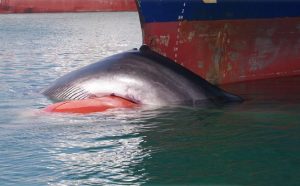
Baleen whale ship strike
Ship strikes
A ship or vessel strike is when a boat and an ocean-dwelling animal collide (accidentally hit each other). This can happen to sea birds, turtles, sharks, fish, seals and cetaceans.
Strikes can happen with any type or size of boat/vessel and are more common in busy stretches of water, for example where oil tankers or container ships travel or passenger ferries cross regularly. It’s important to remember that ship strikes are accidental, the skipper of the vessel just won’t see the animal in time because, whales for example travel mainly under the water. Whales are most affected by being hit by vessels and this is because fast- travelling vessels often cross their habitats (places where they live), and annual migration routes (when a whale travels to northern and southern oceans to feed, mate, and have their young). Just like we love tasty food, so do whales, and they follow their food (fish or krill) to make sure they have enough to eat.
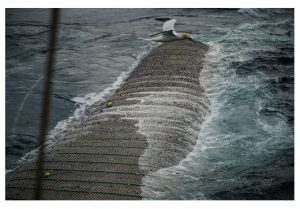
Enormous nets full of fish are taking too much from the ocean
Overfishing
Just like cetaceans love fish, so do we humans! The problem is that we (humans) take far too much fish from the oceans and are not slowing down! Even though we know that the number of fish is decreasing (becoming smaller), we don’t seem to change the quantity that we take. Over the years our fishing boats have become much larger, more efficient, and our fishing gear has also become much better at catching fish. Nowadays, we take salt and ice aboard with us so that we can store and keep the fish fresh, whilst we continue to fish, for sometimes weeks at a time, whereas years ago we would go out fishing for a day at a time, giving the fish a chance to have their young and therefore grow in numbers again. We also tend to fish every day of the year but used not to. We used to fish in season, allowing fish stocks to replenish by not fishing all year around.
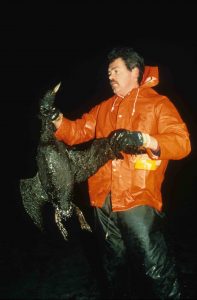
A Great Northern Diver rescued but covered in oil
Pollution
Sadly, pollution of our planet comes in all shapes and forms. Pollution of our seas can be from oil (oil leaks from tankers), plastic (bags, bottles, toys, packaging etc, chemicals (from factories and production) and more.
Plastic items break down over time until they become minute beads (nurdles) and get absolutely everywhere! If you have ever scooped up a hand full of sand and looked at it closely enough you will probably have found tiny, rounded beads in amongst it. Believe it or not this is plastic! Fish and other animals digest this, and then mammals eat the fish and so the plastic is carried on up the food chain.
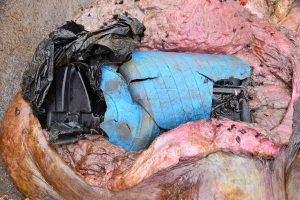
Masses of plastic found in a sperm whale’s stomach
Some beached cetaceans have been found to have so much plastic in their stomachs they aren’t able to digest their food any longer and so starve and die.
Pollution can also come directly from rivers that run into the sea. This can be because of rubbish or chemicals entering the river (pesticides from farms), or again, chemicals from factories.
Disturbance
Disturbance can come from various sources like boats, jet skis, navy sonar, or drilling, perhaps from an oil rig.
Boat traffic increases during the summer months in the UK when people are on holiday and out enjoying the water on
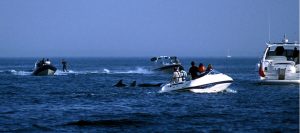
Three dolphins surrounded by summer boat activity
their jet skis or speed boats. This extra activity creates a lot of noise which sometimes gets too close to cetaceans, and is a particular problem when mothers have their calves during the summer months.
Sonar stands for ‘sound navigation and ranging’ and is used often by the navy for submarine navigation. Sometimes the testing of a submarine’s sonar can occur too close to where cetaceans exist, or to where their annual migration occurs, and it can seriously confuse their own sonar that they also use to navigate and find food. If this happens the animals can become so disorientated that they lose their way and can end up stranded on land. This has been know to happen to entire pods of dolphins and whales.

